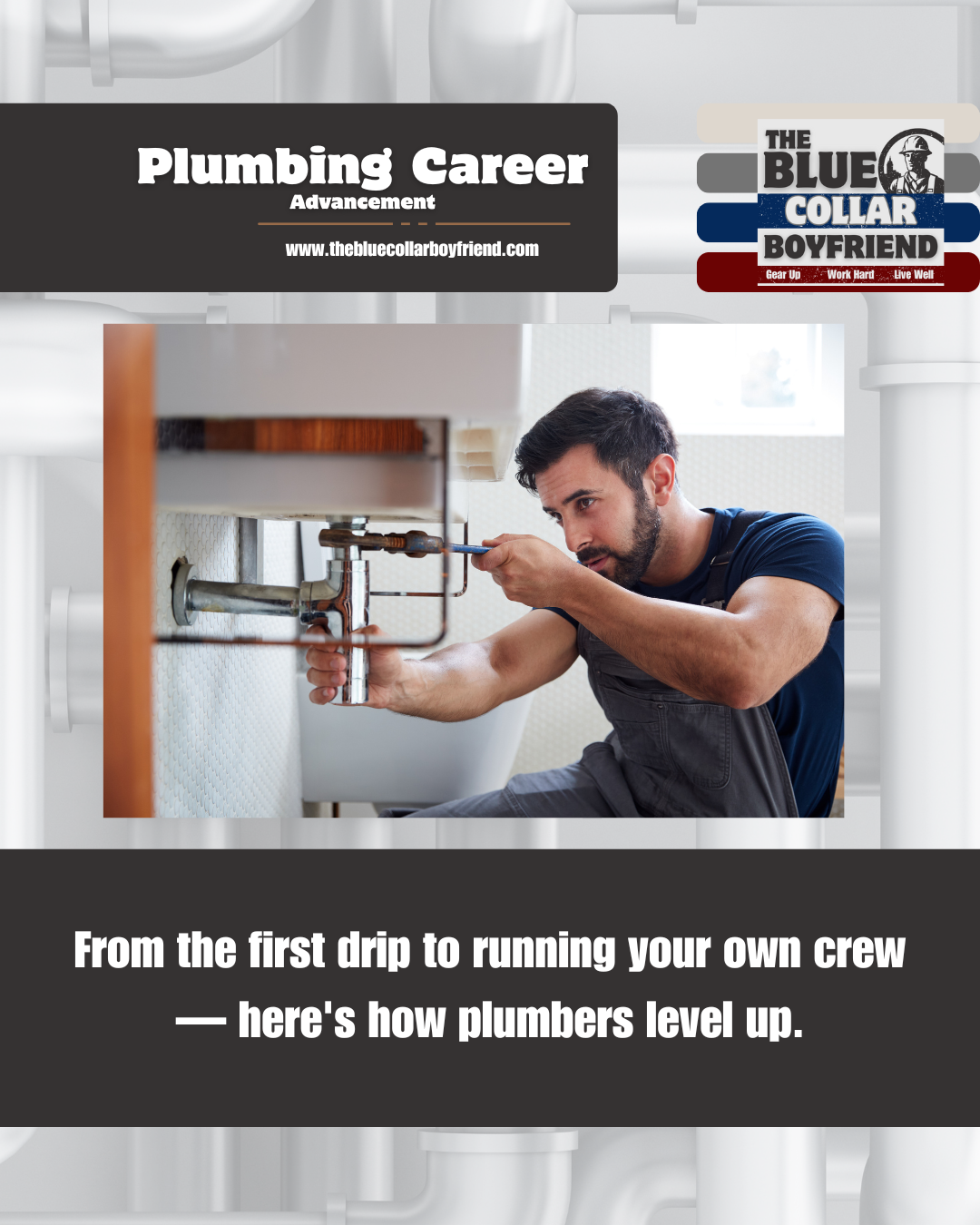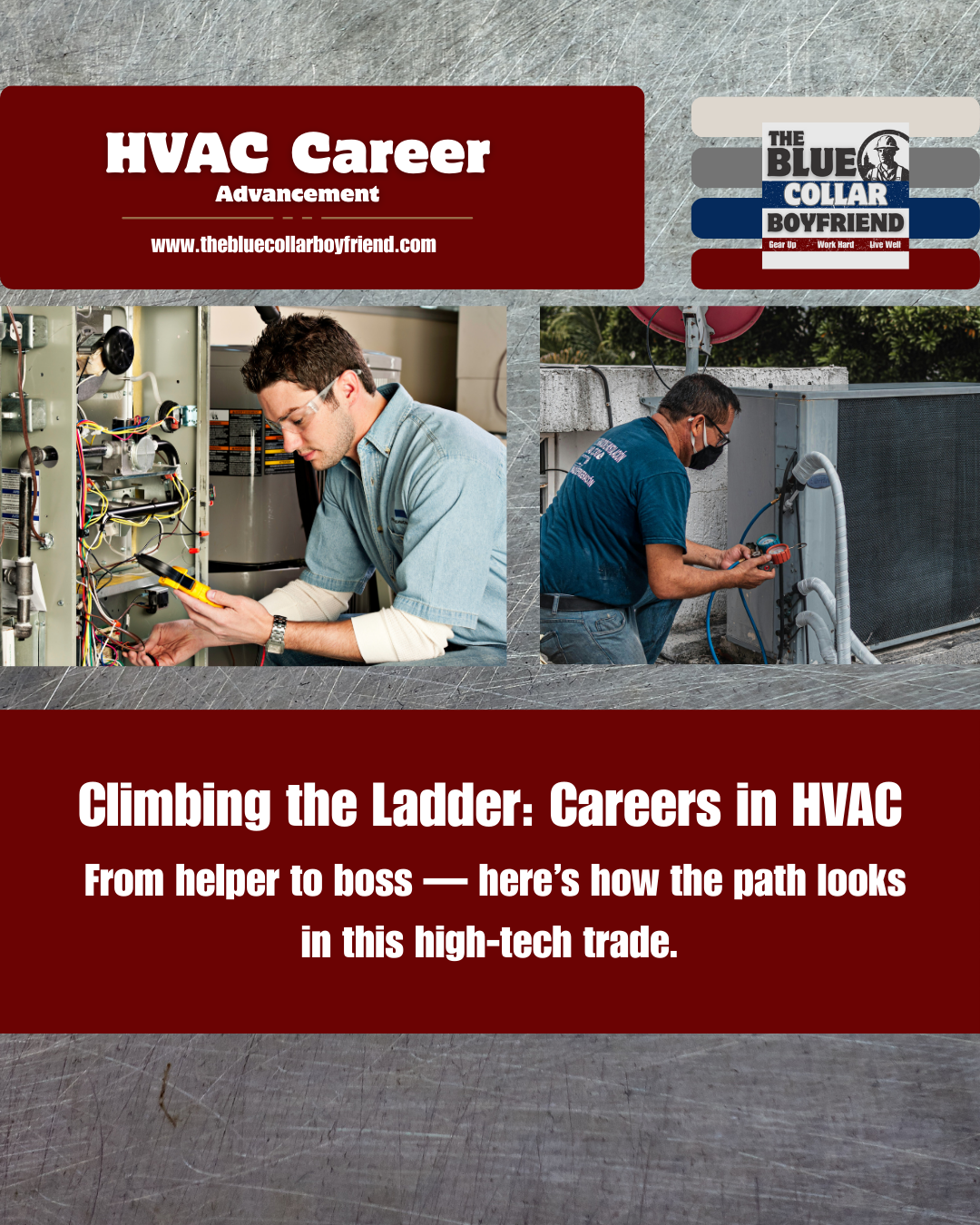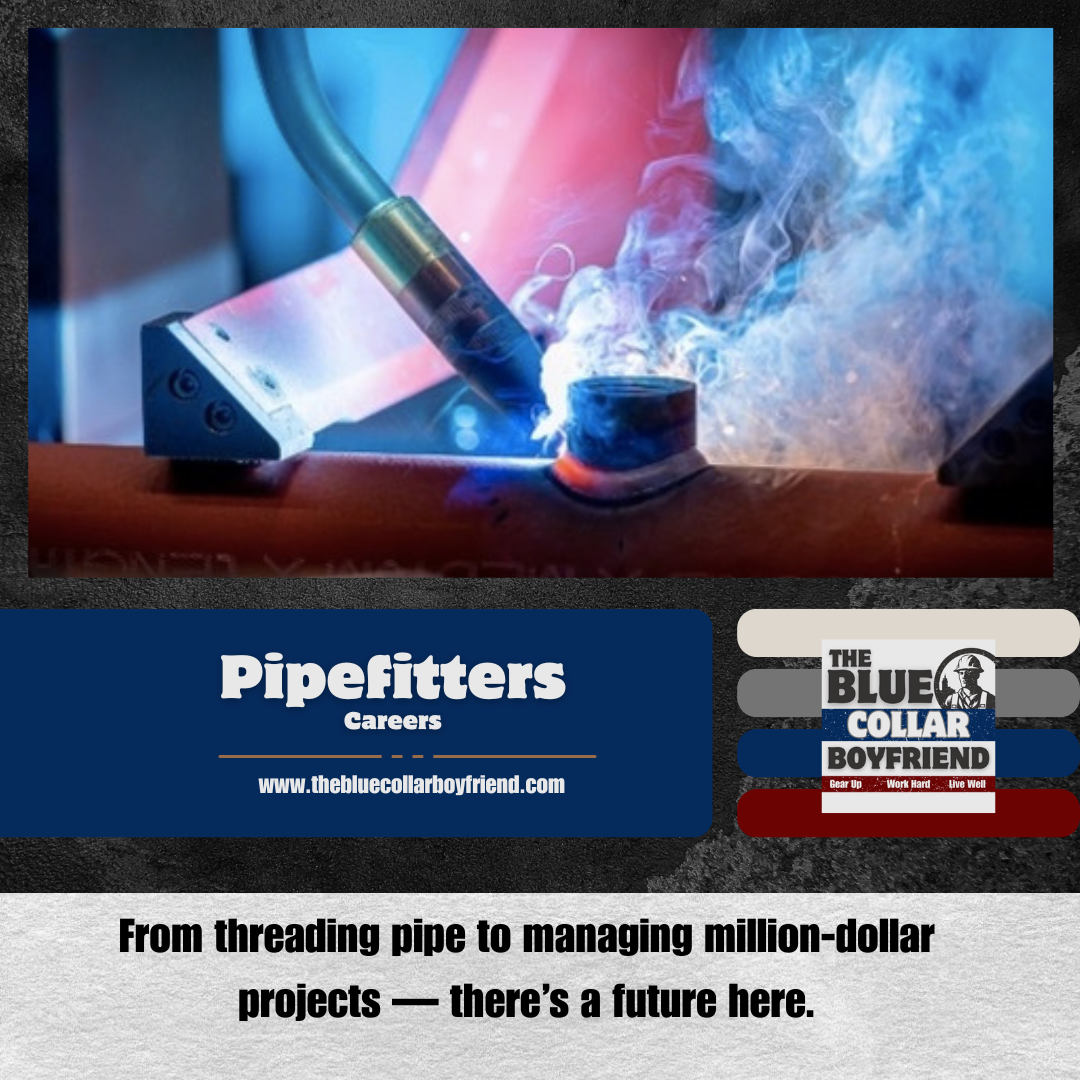
Climbing the Ladder: Careers in Plumbing
.
🧰 1. Plumbing Helper / Laborer
Entry-level support role — boots on the ground and eyes wide open
If you’re new to the trades, this is often your first paid job on a jobsite. Helpers assist licensed plumbers by:
Carrying and organizing tools
Digging trenches and cutting pipe
Hauling materials and setting fixtures
Cleaning up and learning jobsite flow
No license or schooling is required, and it's a great way to see if this path fits you.
✅ “You’re on site early, learning from the best, and not afraid to get muddy.”
🔩 2. Apprentice Plumber
Learn while you earn — the trade school of the real world
Most apprenticeships last 4–5 years and may be through a union, trade school, or directly with a contractor. During this phase, you’ll study:
Pipe sizing and material types (PVC, copper, cast iron, PEX, etc.)
Drainage, venting, and code compliance
Gas fitting and water system layouts
Tool use, safety, and troubleshooting
You’ll combine classroom hours with paid on-the-job training, and likely need to register with your state or local licensing board.
✅ “From PVC to copper to cast iron — you’ll know what to use, when, and how.”
🛠️ 3. Journeyman Plumber
Licensed and trusted — ready to run your own jobs
As a journeyman, you’re legally allowed to install, repair, and maintain plumbing systems without supervision. That might include:
Rough-in and finish work for homes or commercial buildings
Gas piping and hot water systems
Fixture installs, water heater service, and sewer repairs
Supervising apprentices and helpers
Journeymen keep systems safe and sanitary — and get called when the water won’t stop or the heat won’t start.
✅ “You’re solving problems, running jobs, and making water flow where it’s supposed to — and only there.”
🎓 4. Master Plumber
Respected, licensed, and in control — your name carries weight now
After working as a journeyman for several years (varies by state), you can take the master plumber exam. Pass it, and you unlock:
The ability to pull permits
Full responsibility for code compliance and system design
Leadership of crews and large projects
The option to start your own business
You’re not just working in the trade — you’re shaping it.
✅ “You’ve earned the title — and now others come to you for the real answers.”
👷 5. Field Leadership Path
Got strong communication and project chops? Lead from the field.
There are plenty of leadership roles that let you stay close to the work while managing people, schedules, and progress:
Lead Plumber: Manages a small crew or specific job area
Foreman: Runs plumbing scope for an entire jobsite
General Foreman / Superintendent: Oversees labor, materials, and subcontractors across big commercial or industrial builds
✅ “You know the tools, but now you’re also managing time, people, and pressure.”
💼 6. Office & Business Roles
Want to work smarter, bid bigger, or run your own operation?
Plumbing experience doesn’t have to stay in the field — many pros transition into planning, estimating, and ownership roles such as:
Project Manager: Oversees timelines, budgets, and subcontractor coordination
Estimator: Reads blueprints and calculates labor, materials, and margins
Service or Branch Manager: Runs a team or division in a region
Plumbing Contractor / Owner: Operates a licensed business, handles permits, payroll, and long-term growth
✅ “You don’t just run jobs — you run the whole operation.”
🔧 Specialty Plumbing Roles Along the Way
These certifications and specialties can increase your skill set, value, and income — often without leaving the tools behind.
Medical Gas Installer (certified)
Backflow Prevention Specialist
Drain Cleaning / Video Inspection Tech
High-Purity Process Piping Installer
Plumbing Inspector or Plan Reviewer
CAD/BIM Plumbing System Designer
✅ These roles often come with better pay, more flexibility, and high demand — especially in healthcare, industrial, and municipal work.
💵 Wages & Job Outlook
Plumbing isn't just a calling — it's a career with real earning potential.
Journeyman Plumbers: $25–$45/hour
Masters, Foremen, and Specialty Techs: $80K–$100K+ annually
Business Owners / Contractors: Potential for six figures and long-term equity
Why demand stays strong:
Aging infrastructure in cities
Residential and commercial growth
Plumbing codes requiring regular retrofits
Shortage of licensed, experienced plumbers nationwide
Final Word from The Blue Collar Boyfriend
Plumbing isn’t just a job — it’s a craft, a career, and a ladder worth climbing. Whether you’re learning how to sweat a joint or reviewing bids on a commercial job, you’re keeping civilization running clean and safe.
💧 “From helping hands to master plans — there’s room to grow in this trade, and pride to go with it.”

Climbing the ladder: careers in HVAC
Climbing the Ladder: Careers in HVAC
From cooling server rooms to keeping homes warm in winter, HVAC pros are the silent heroes of modern life. If you've ever had your A/C go down on a 95° day, you know exactly how valuable this trade is.
But HVAC isn’t just essential — it’s a smart career with long-term opportunity, solid wages, and room to specialize or lead.
Whether you’re looking to break into the trades or want to level up, here’s a look at how careers in HVAC typically progress — from helper to high-level expert.

Climbing the Ladder: Careers in Pipefitting
🔧 Climbing the Ladder: Careers in Pipefitting
When people think about the trades, pipefitting doesn’t always get the spotlight — but it should. This is a high-skill, high-responsibility trade that literally keeps power plants, factories, and entire cities running.
Pipefitters don’t just “install pipes.” They work with high-pressure systems, steam, chemical lines, and complex blueprints. It’s a trade where precision matters, teamwork is essential, and the rewards are real.
Whether you’re just getting your boots muddy or thinking about leveling up, here’s what the career path looks like in pipefitting — and why it might be the right move for you.
🧰 1. Pipefitter Helper / Laborer
Start here. Learn fast. Show up early.
This entry-level role supports journeymen and foremen on industrial or commercial job sites. You’ll be tasked with things like tool setup, pipe transport, layout, rigging, and assisting with basic cuts and prep work.
No license required. No school needed. Just a willingness to work hard and learn fast.
✅ “You’re hauling pipe, running tools, and watching how the real ones get it done.”
🔩 2. Pipefitting Apprentice
Hands-on learning meets high-stakes systems.
Most apprenticeships run 4–5 years and combine classroom learning with paid on-the-job training. You’ll study blueprint reading, pipe welding, safety codes, math, rigging, layout, and system installation.
Depending on your region, this can be through a union apprenticeship or open shop program. Either way, you’re building skills that pay for a lifetime.
✅ “It’s all starting to click — the cuts, the codes, the crew. You’re not just showing up, you’re stepping up.”
🛠️ 3. Journeyman Pipefitter
Now you’re certified, skilled, and trusted.
Journeymen are licensed to work unsupervised and can lead small crews. You’ll be installing, maintaining, and repairing high-pressure piping systems in industrial plants, commercial buildings, refineries, or shipyards.
Specialties might include:
Power & steam systems
Industrial gas systems
Pipe welding (TIG/MIG/Stick)
Rigging & layout
Medical or chemical process piping
✅ “You’ve got the tools and the know-how — and now they’re sending the new guys to you.”
🎓 4. Foreman / General Foreman / Superintendent
From laying pipe to leading people.
Foremen run job sites, coordinate crews, manage materials, enforce safety, and keep the schedule moving. General Foremen or Superintendents oversee multiple crews and larger scopes of work.
If you're strong with logistics and leadership, this is the path that blends your hands-on experience with project-level impact.
✅ “You’re not just fitting pipe — you’re managing the pressure.”
💼 5. Office & Business Roles
Want to leave the tools behind? You’ve got options.
Many seasoned pipefitters transition into roles like:
Project Manager – coordinates subs, budgets, change orders
Estimator – reviews blueprints, scopes work, bids projects
Pipefitting Inspector – checks systems for code, safety, and quality
Business Owner / Contractor – runs your own shop, builds a legacy
✅ “You’ve been in the trenches. Now you’re calling the shots — and making sure the next crew does it right.”
🔥 Specialty Paths in Pipefitting
Along the way, many pipefitters find their niche in high-demand specialties like:
Pipe welding (certified TIG/MIG)
High-purity process piping (pharma, semiconductors)
Medical gas installation (requires certification)
Steam fitting
HVAC/R piping systems
Nuclear plant or refinery work
Offshore or traveling industrial gigs
These specialties often come with premium pay and long-term career security.
💵 Wages & Demand
Journeyman pipefitters typically earn $25–$45/hour
Foremen and specialty welders can exceed $80K–$100K+
Union work offers benefits, retirement, and steady upgrades
Demand is high due to aging infrastructure, energy projects, and skilled trades shortages across the country
Final Word from The Blue Collar Boyfriend
Pipefitting isn’t a fallback job. It’s a career with structure, respect, and serious earning potential.
You start with a strong back and a willingness to learn. You end up with a certified skillset that powers everything from hospitals to power plants.
If you’re good with your hands, proud of your work, and ready to build something that lasts — this ladder’s for you.
🧰 “Work hard, learn smart, and leave every weld tighter than you found it.”
🔗 Want to explore gear, tools, and workwear for pipefitters?
Check out our affiliate picks for boots, tools, and safety gear that get the job done → [Link to gear roundup blog]
